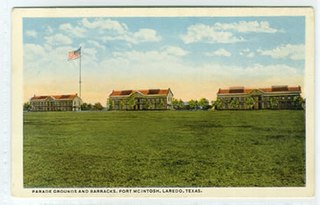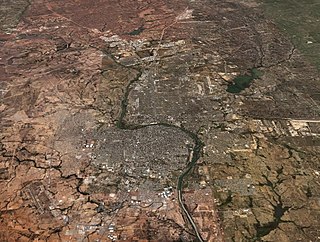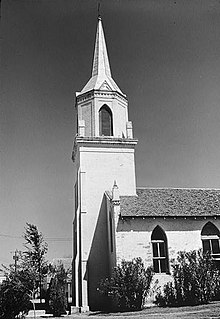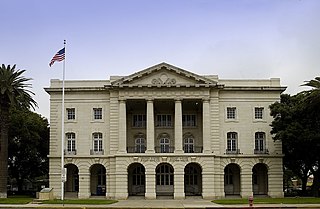
South Texas is a region of the U.S. state of Texas that lies roughly south of—and including—San Antonio. The southern and western boundary is the Rio Grande, and to the east it is the Gulf of Mexico. The population of this region is about 4.96 million according to the 2017 census estimates. The southern portion of this region is often referred to as the Rio Grande Valley. The eastern portion along the Gulf of Mexico is also referred to as the Coastal Bend.

Fort McIntosh was a U.S. Army base in Laredo, Webb County, Texas, that existed from 1849 to 1946.

"Six flags over Texas" is the slogan used to describe the six nations that have had sovereignty over some or all of the current territory of the U.S. state of Texas: Spain, France (1685–1690), Mexico (1821–1836), the Republic of Texas (1836–1845), the Confederate States of America (1861–1865), and the United States of America.

Los Ojuelos is a ghost town near Mirando City in the southeastern part of Webb County, Texas, United States. Before its establishment, Indians camped near the only dependable water source in the semiarid area. The local springs attracted Eugenio Gutiérrez in 1810 and attempted to settle in the area. Frequent Indian attacks forced Gutiérrez to abandon the site. in 1835, Eugenio's son returned to the site and tried to resettle the area but Indian attacks drove him back. In 1850, a company of Texas Rangers were stationed on the site to protect the trade route Laredo, Texas - Corpus Christi, Texas. In 1857, José María Guerra, grandson of Eugenio Gutiérrez and an ancestor of Laredo businessman Joe A. Guerra, built an irrigation system and a wall around Los Ojuelos to protect from Indian attacks.

Republic of the Rio Grande Museum is a historic house museum located in the downtown San Agustin de Laredo Historic District in Laredo, Texas, United States, next to the historic La Posada Hotel and San Agustín Cathedral. The Mexican vernacular structure was built in 1830 as a house with an addition in 1860. Among the people who have lived there was prominent rancher Bartolomé García, who was also one of Laredo's mayors, and who is a descendant of the town founder, Tomas Sanchez.

The Laredo–Nuevo Laredo Metropolitan Area is one of six bi-national metropolitan areas along the U.S.-Mexican border. The city of Laredo is situated in the U.S. state of Texas on the northern bank of the Rio Grande and Nuevo Laredo is located in the Mexican State of Tamaulipas in the southern bank of the river. This metropolitan area is also known as the Two Laredos or the Laredo Borderplex. The metropolitan area is made up of one county: Webb County in Texas and three municipalities: Nuevo Laredo Municipality in Tamaulipas, Hidalgo Municipality in Coahuila, Anáhuac Municipality in Nuevo León in Mexico. Two urban areas: the Laredo Metropolitan Statistical Area and the Zona Metropolitana Nuevo Laredo three cities and 12 towns make the Laredo–Nuevo Laredo Metropolitan area which has a total of 636,516 inhabitants according to the INEGI Census of 2010 and the United States Census estimate of 2010. The Laredo–Nuevo Laredo is connected by four International Bridges and an International Railway Bridge. According to World Gazetteer this metropolitan area ranked 157th largest in North and South America in 2010 with an estimated population of 775,481. This area ranks 66th in the United States and 23rd in Mexico.

The Cathedral of San Agustin is the seat of the Catholic Diocese of Laredo, Texas. It is located at 214 San Bernardo Avenue in the heart of the downtown area in the San Agustin Historical District. The present church building dates from 1872. The bishop is James Anthony Tamayo. As of 2000, the cathedral was the mother church for 289,415 Catholics in the diocese.

The Roma Historic District in Roma, Texas preserves an intact example of a border town in the lower Rio Grande valley. The town was an important port and transshipment point on the Rio Grande from 1829 to the 1880s.

Tomás Sánchez de la Barrera was a veteran Spanish captain who founded Laredo, Texas, United States, and Nuevo Laredo, Tamaulipas, Mexico, the only town in the Nuevo Santander province.

The U.S. Post Office and Courthouse is a historic government building located in Laredo in Webb County, Texas. It previously served as a custom house and a courthouse for the United States District Court for the Southern District of Texas. It continues to serve as a post office.

The Atascosa County Courthouse is a historic courthouse built in 1912 on Circle Dr in Jourdanton, Texas. The Mission Revival Style architecture building was designed by San Antonio architect Henry T. Phelps. The building contract was awarded to the Gordon Jones Construction Co. of San Antonio, based on a bid of $65,000. It was added to the National Register of Historic Places on December 30, 1997. Atascosa County was formed in 1856. The first Atascosa County Courthouse was a log building erected in Amphion in 1856. The second a frame building raised in Pleasanton in 1857. The county built a larger frame courthouse in 1868. The fourth courthouse, built in 1885 was made from red stone and served as the Pleasanton City Hall when the county seat was moved to Jourdanton.

El Azteca is one of the oldest and most intact residential neighborhoods in Laredo, Texas, with buildings dating from the 1870s representing nearly every major architectural type and style that has appeared on the border since that time.

The Presidio Chapel of San Elizario was built in 1877 at the same place where an earlier Mexican chapel stood. The building is located in the central square of San Elizario, 17.5 miles south-southeast of El Paso. It was listed on the National Register of Historic Places in 1972. It is an example of the Spanish Colonial style.

The Clifton Townsite Historic District, in Clifton, Arizona, is a 37-acre (15 ha) historic district that was listed on the National Register of Historic Places in 1990.
The following is a timeline of the history of the city of Laredo, Texas, USA.

Los Luceros Hacienda, in Rio Arriba County, New Mexico near Los Luceros, New Mexico, is a historic site which was listed on the National Register of Historic Places in 1983. The hacienda property adjoins, or is close to, the Rio Grande. It is on a private road about .25 miles (0.40 km) off County Route 41

























